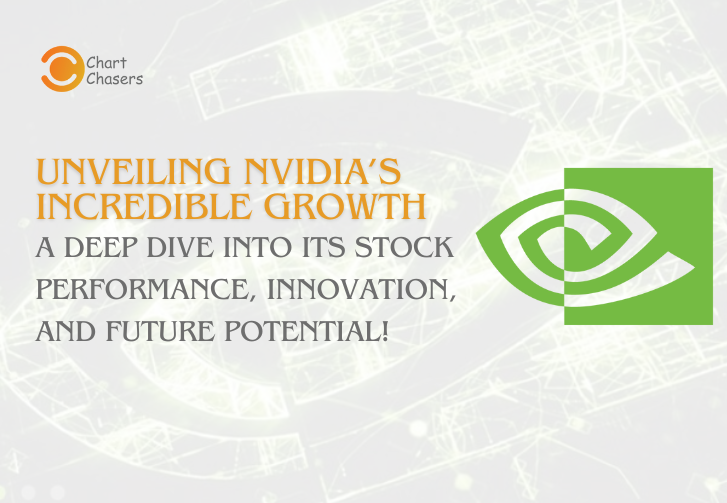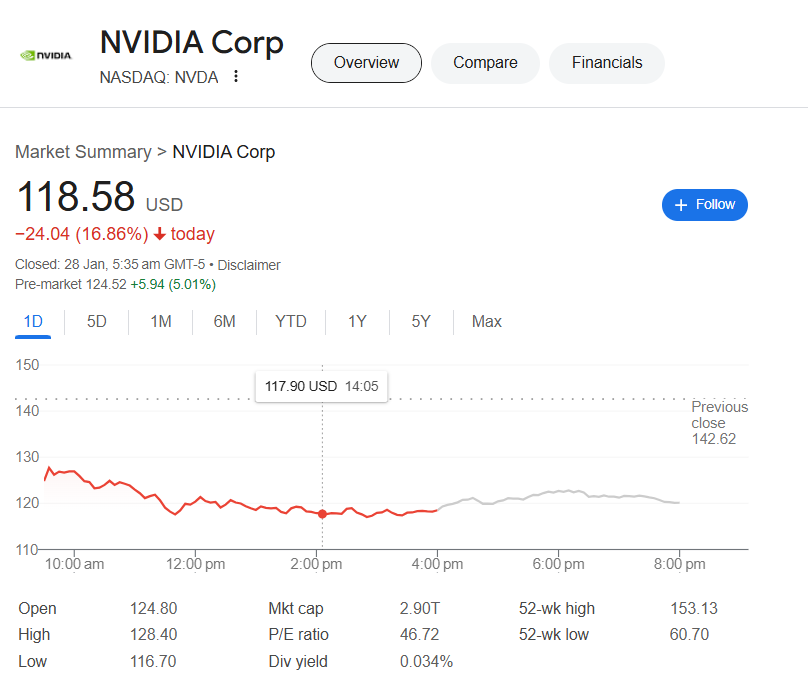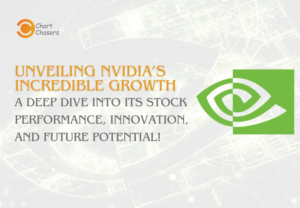
Nvidia Corporation, a powerhouse in the tech industry, has reshaped the landscape of computing with its cutting-edge graphics processing units (GPUs). The company’s innovations have been instrumental in the rise of artificial intelligence (AI), gaming, and cloud computing. As one of the most valuable companies in the world, Nvidia’s stock has garnered considerable attention. In this case study, we’ll dive deep into Nvidia’s history, business model, stock performance, and future outlook.
History and Background of Nvidia

Nvidia was founded in 1993 by Jensen Huang, Chris Malachowsky, and Curtis Priem, with the aim of creating advanced graphics technology. Initially focused on gaming, Nvidia soon expanded into professional markets, creating GPUs that would power everything from gaming consoles to scientific simulations. Over the years, Nvidia has evolved from a niche player in the gaming market to a leader in AI and data center technologies.
Nvidia’s Core Business Model
Nvidia operates in multiple sectors, with its core focus on developing high-performance GPUs. The company serves a variety of markets, including gaming, AI, data centers, and autonomous vehicles. Its business is divided into two major segments: the gaming division, which produces graphics cards for consumers and developers, and the data center division, which serves enterprise-level needs such as AI workloads and deep learning.
In addition to GPUs, Nvidia has expanded its offerings through acquisitions, like the purchase of Mellanox Technologies in 2020, which enhanced its data center capabilities. The company’s products are crucial to major tech players, including Amazon Web Services, Google, and Microsoft.
Nvidia’s Technological Innovations
Nvidia has been at the forefront of technological advancements in various sectors. The company’s GPUs are critical for AI computations, and Nvidia has developed specialized chips like the Tesla and A100 for AI workloads. Its RTX series of graphics cards revolutionized gaming with real-time ray tracing, delivering more realistic visuals than ever before.
Nvidia also plays a pivotal role in the development of self-driving cars. Its Drive platform, which combines hardware and software, has become a key player in the autonomous vehicle market.
Nvidia’s Stock Performance Over Time
Nvidia’s stock has shown significant growth over the years, thanks to its continued innovation and expansion into new markets. In 2016, Nvidia’s stock saw a dramatic surge, largely driven by the company’s leadership in AI and its strong presence in the gaming market. The stock continued its upward trajectory, with key milestones such as its 2020 acquisition of Mellanox, which further boosted investor confidence.
One of the most remarkable stock movements occurred in 2020 and 2021, when Nvidia’s stock price skyrocketed in response to increasing demand for gaming and AI-related products. Despite some market corrections, Nvidia’s long-term growth potential remains strong, making it a favorite among investors.
Factors Affecting Nvidia’s Stock Price

Several factors influence Nvidia’s stock price, including market conditions, competition, product releases, and investor sentiment. Global economic events, such as the pandemic or chip shortages, can affect Nvidia’s production capabilities and sales.
Moreover, Nvidia’s stock price is impacted by the performance of its competitors, such as AMD and Intel. As the market for GPUs continues to grow, Nvidia’s ability to maintain a technological edge is crucial to its stock performance.
Analysis of Nvidia’s Financial Performance
Nvidia has consistently reported strong financial results. Its revenue growth has been robust, driven by its GPU business and expanding data center segment. In fiscal 2024, Nvidia reported record revenues, primarily due to the surge in demand for GPUs and AI-related technologies.
The company’s profitability is impressive, with margins consistently exceeding industry averages. Its balance sheet remains strong, with significant cash reserves and low debt levels, providing the company with the flexibility to continue its expansion.
Nvidia’s Competitive Advantage
Nvidia’s dominant position in the GPU market is a key factor behind its competitive advantage. The company’s continued investment in research and development allows it to stay ahead of competitors. Nvidia’s partnership with major players in the tech and automotive sectors further strengthens its position.
The company’s leadership in AI, gaming, and data centers has made it an essential player in the tech ecosystem. Nvidia’s innovations continue to set the bar for others in the industry, ensuring its long-term success.
The Role of Nvidia in AI and Data Science
Nvidia’s GPUs are a driving force behind AI and machine learning advancements. Its CUDA programming platform has become the standard for developers working on AI and deep learning applications. Nvidia’s technology powers everything from autonomous vehicles to drug discovery.
Looking ahead, Nvidia’s continued role in AI will be crucial. As industries continue to embrace AI, the demand for Nvidia’s GPUs will likely increase, further driving its stock performance.
Investor Sentiment and Market Trends
Nvidia is widely regarded as a strong investment, thanks to its consistent growth and technological leadership. The company’s stock is considered a top pick for long-term investors looking to capitalize on the rise of AI and gaming.
However, Nvidia’s stock is not without risks. Fluctuations in the stock market and competition from other chipmakers can impact its stock price. Nevertheless, Nvidia’s strong fundamentals and innovation make it an attractive option for investors.
Stock Valuation of Nvidia
When valuing Nvidia’s stock, investors often look at key financial ratios such as price-to-earnings (P/E) and price-to-sales (P/S). Nvidia’s P/E ratio has been higher than the industry average, reflecting its growth potential. The company’s high market capitalization and strong financial performance contribute to its premium valuation.
Nvidia’s valuation is often compared with its main competitors, such as AMD and Intel. Despite the competition, Nvidia’s dominant market share and cutting-edge technology justify its higher valuation.
Recent Developments and Market Movements
In recent years, Nvidia has been actively expanding its reach through strategic acquisitions and new product launches. The company’s 2020 acquisition of Mellanox was a major step toward solidifying its position in the data center market. Additionally, Nvidia’s planned acquisition of ARM Holdings, although not yet finalized, could further enhance its capabilities in mobile and embedded computing.
The stock has experienced fluctuations due to market trends and investor reactions to these acquisitions. However, Nvidia’s strong fundamentals have allowed it to weather these fluctuations.
Risks and Challenges for Nvidia
While Nvidia’s future looks promising, there are several risks and challenges to consider. The company faces stiff competition from AMD, Intel, and other tech giants. Additionally, Nvidia must navigate regulatory challenges, particularly related to its acquisitions and global business operations.
Supply chain issues, particularly the ongoing chip shortages, could also impact Nvidia’s ability to meet demand. However, the company’s proactive approach to securing supply chain partnerships may mitigate some of these risks.
Future Prospects for Nvidia
Nvidia’s growth potential remains strong, particularly in AI, gaming, and data centers. The company is well-positioned to capitalize on the ongoing digital transformation across industries. As AI and machine learning continue to evolve, Nvidia’s products will be critical to advancing these technologies.
Looking ahead, Nvidia’s stock could see continued growth as demand for its products expands. The company’s investments in AI, autonomous vehicles, and cloud computing are likely to drive long-term success.
Conclusion
Nvidia has established itself as a leader in the tech industry, driven by its innovative products and strategic investments. The company’s stock performance has reflected its success, and Nvidia remains a strong contender in the AI, gaming, and data center markets. As an investor, Nvidia presents both significant opportunities and risks, but its long-term growth prospects make it an attractive option for those looking to capitalize on the future of technology.






